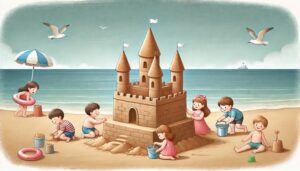Beach Art: Where Creativity Meets the Shore

The Beauty of Beach Art
Beach art, also known as sand art or coastal art, transforms ordinary stretches of shoreline into extraordinary canvases. Artists use natural elements such as sand, shells, driftwood, and seaweed to create ephemeral masterpieces that captivate both locals and tourists. This unique form of art reflects the transient nature of the beach itself, constantly shaped and reshaped by the forces of wind and water.
Different Forms of Beach Art
Beach art takes many forms, from intricate sand sculptures to large-scale environmental installations. Sand sculptures, often the most recognized form of beach art, range from simple sandcastles to elaborate, lifelike representations of people, animals, and fantastical creatures. These sculptures often require immense skill and patience, as artists must carefully balance moisture content and structural integrity to achieve their visions.
Driftwood sculptures and installations use pieces of wood washed ashore to create abstract or representational works. These pieces often evoke a sense of connection to the ocean, as the driftwood’s journey through the sea becomes part of the artwork’s story.
Famous Beach Art Locations
Certain beaches around the world have become renowned for their beach art. For example, the annual sand sculpture festivals in places like Weston-super-Mare in England and Port Aransas in Texas draw thousands of visitors. These events feature competitions where artists create stunning works in a limited time frame, showcasing their talent and creativity.
Other beaches, like those in Goa, India, and Cannon Beach, Oregon, are known for their community-driven beach art projects. Here, locals and visitors alike can contribute to large-scale installations, fostering a sense of collaboration and shared appreciation for the art form.
Creating Your Own Beach Art
Creating beach art can be a rewarding and meditative experience. All you need is a stretch of sand and a few basic tools. For sand sculptures, tools like shovels, buckets, and carving instruments can help you achieve detailed designs. For driftwood or shell art, simply walking along the shore can provide all the materials you need.
When creating beach art, it’s important to be mindful of the environment. Use natural materials found on the beach and avoid disturbing local wildlife or ecosystems. Beach art is meant to be temporary and harmonious with its surroundings, leaving no trace once it’s washed away by the tide.
The Impact of Beach Art on Communities
Beach art can have a significant impact on local communities. It draws visitors, supports local economies, and fosters a sense of pride and identity. Festivals and events centered around beach art create opportunities for artists to showcase their work and for communities to come together in celebration of creativity and natural beauty.
In some cases, beach art also serves as a platform for environmental awareness. Artists use their work to highlight issues such as plastic pollution, climate change, and habitat conservation, encouraging viewers to reflect on their relationship with the natural world.
Beach Art as a Form of Expression
For many artists, beach art is a powerful form of expression. The ever-changing nature of the beach provides a dynamic canvas where artists can experiment and innovate. The temporary aspect of beach art challenges artists to embrace impermanence and live in the moment, knowing their work will eventually be reclaimed by the sea.
This form of art also invites participation and interaction. Passersby often engage with the artwork, adding their own touches or simply marveling at the creativity on display. This interaction creates a unique connection between the artist, the viewer, and the environment, making beach art a truly communal experience.
Conclusion
Beach art is a celebration of nature’s beauty and human creativity. From intricate sand sculptures to inspiring driftwood installations, this art form transforms the shoreline into a gallery of fleeting wonders. Whether you’re a seasoned artist or a curious beachgoer, beach art offers a way to connect with the natural world and express your creativity in a unique and meaningful way.



